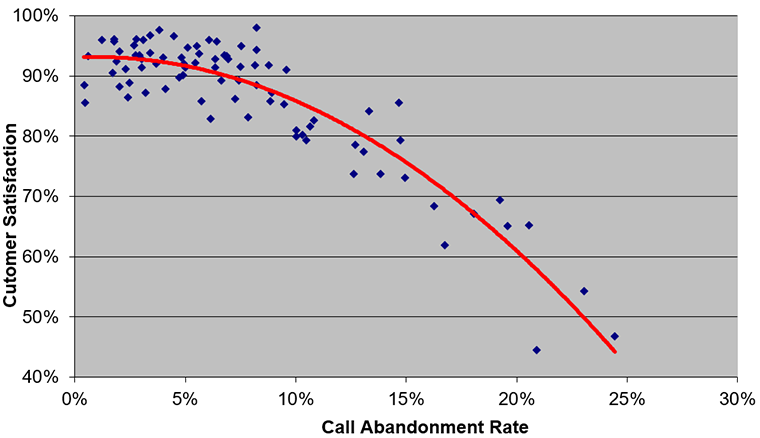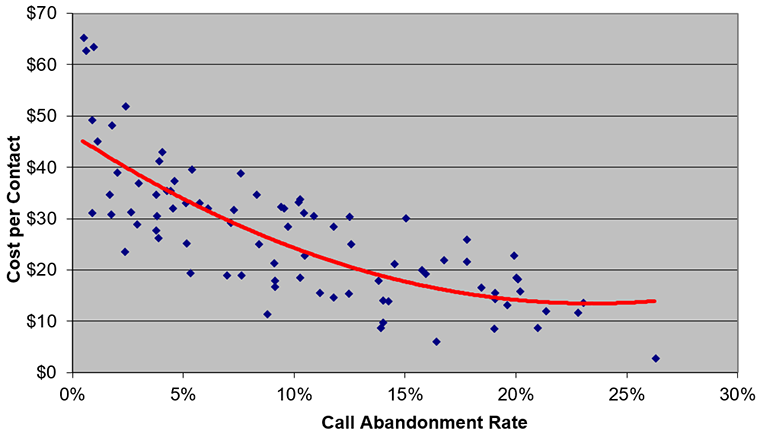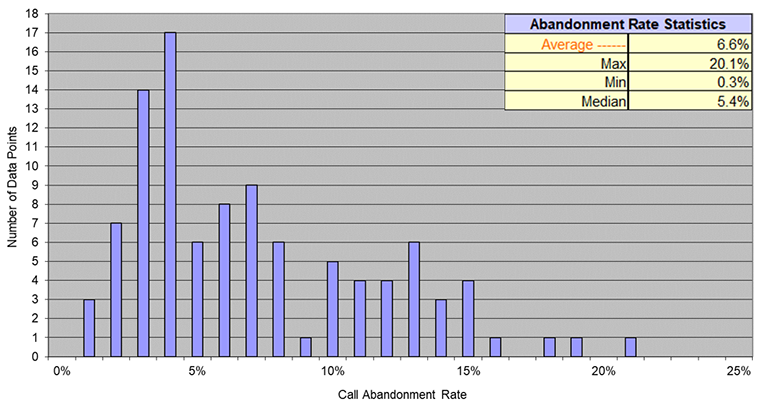Date Published April 16, 2019 - Last Updated December 17, 2019
Each month, I highlight one Key Performance Indicator (KPI) for service and support. I define the KPI, provide recent benchmarking data for the metric, and discuss key correlations and cause-and-effect relationships for the metric. The purpose of the column is to familiarize you with the KPIs that really matter to your organization and to provide you with actionable insight on how to leverage these KPIs to improve your performance! This month, I look at call abandonment rate.
An abandoned call is one where the caller hangs up before being connected to a live agent in the service desk. Call abandonment rate is the number of abandoned calls divided by all calls offered to the service desk and is one of the most widely tracked metrics in the service desk industry. Virtually every service desk with an ACD has the ability to track this metric.
With the advent of chat, and the increasing number of support requests handled through chat, abandonment rate has come to signify both abandoned calls and abandoned chat sessions (i.e., chat sessions that are initiated by the user but abandoned before an agent responds). Ideally chat and voice abandonment rates should be tracked separately, as any significant imbalance between the two abandonment rates could indicate an imbalance in staffing between the two channels. For purposes of this article, abandonment rate will refer to abandoned voice calls, but the principles discussed apply equally to abandoned calls and abandoned chats.
Why It’s Important
Many service level agreements include an abandonment rate target. Although a low abandonment rate is a worthy objective, many service desks go too far in trying to reduce abandoned calls. Those who pursue this strategy typically believe that a low abandonment rate is a prerequisite for achieving high customer satisfaction levels. The truth, however, is that a low abandonment rate will not necessarily lead to higher levels of customer satisfaction. As discussed in a prior Metric of the Month, the real driver of customer satisfaction is first contact resolution rate. So while customers may be willing to forgive an occasional abandoned call, they are far less forgiving of calls that are not resolved on first contact.
A low abandonment rate will not necessarily lead to higher levels of customer satisfaction.

The figure below shows the relationship between abandoned calls and customer satisfaction for a representative cross section of North American service desks. At low abandonment rates, the relationship between customer satisfaction and abandonment rate is almost flat, meaning that abandonment rate has very little impact on customer satisfaction levels. It is only when the abandonment rate increases above seven or eight percent that customer satisfaction begins to drop off significantly.

While low abandonment rates have virtually no impact on customer satisfaction, they do have a direct impact on cost per contact. In fact, the lower the abandonment rate is, the higher the cost per contact will be. The figure below illustrates this phenomenon.

So why do costs go up as the abandonment rate goes down? Because more agent headcount is required to achieve lower abandonment rates, and as headcount increases, so too does the cost of support. Let’s say, for example, that a service desk with 10 full-time agents has an average abandonment rate of 8%. To reduce the abandonment rate to 4% would require a full-time agent headcount of approximately 13. That’s a 30% increase in headcount, for a 4-percentage-point decrease in abandonment rate. Is that worth it? Apparently not, because the added headcount increases costs significantly, but produces very little benefit in terms of higher customer satisfaction.
This suggests that there is an optimal range for call abandonment rate. If you go much above this range, customer satisfaction will drop off fairly quickly. If you go much below the range, costs will rapidly climb. Benchmarking data shows that the optimal range for abandoned calls is between 4% and 7%. Operating within this range will keep a service desk off the steepest part of the cost curve at low abandonment rates and also prevent a dramatic drop off in customer satisfaction at higher abandonment rates.
Benchmark Data for Call Abandonment Rate
Industry data from MetricNet’s benchmarking database shows that the average call abandonment rate for all service desks is 6.6%. Additionally, the number of service desks operating outside the optimal range is somewhat surprising. This suggests that service desks operating at low call abandonment rates may be unaware of the heavy price they pay for this performance. Conversely, service desks operating at high abandonment rates may be unaware of the adverse impact their abandonment rate has on customer satisfaction.

Please join me for next month’s Metric of the Month: Agent Training Hours, a metric that has implications for first contact resolution rate, customer satisfaction, and agent job satisfaction.
Jeff presented a metrics deep dive pre-conference workshop at HDI 2019.
Learn more!
Jeff Rumburg is the winner of the 2014 Ron Muns Lifetime Achievement Award, and was named to HDI’s Top 25 Thought Leaders list for 2016. As co-founder and CEO of MetricNet, Jeff has been retained as an IT service and support expert by some of the world’s largest corporations, including American Express, Hewlett Packard, Coca-Cola, and Sony. He was formerly CEO of the Verity Group and Vice President of Gartner. Jeff received his MBA from Harvard University and his MS in Operations Research from Stanford University. Contact Jeff at
[email protected]
. Follow MetricNet on Twitter @MetricNet.